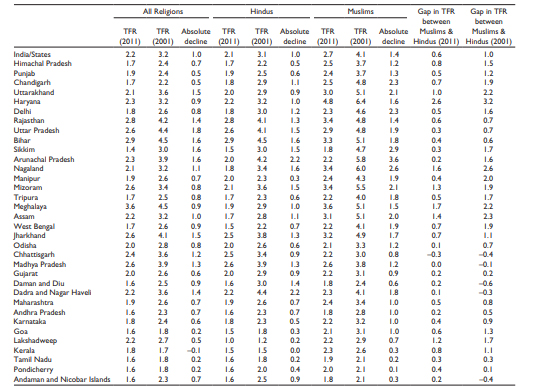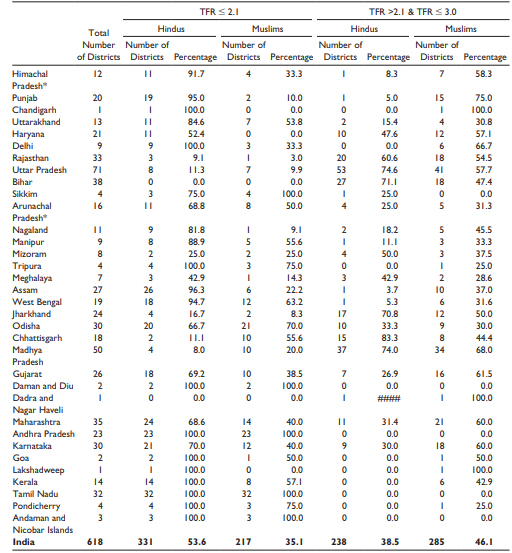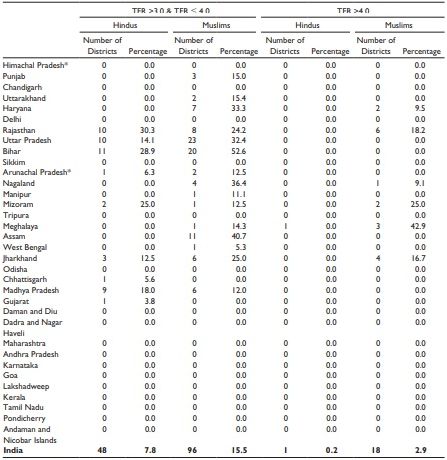The 2011 Indian Census data show a higher growth rate of Muslim population compared to the Hindu population. This article provides an in-depth picture of Hindu-Muslim fertility differentials at the district level and their trends at the state level. It shows that fertility transition has been steady during the last decade; overall convergence of fertility rates between Hindus and Muslims has been underway but significant regional variations persist.
Like earlier decades, the 2011 Indian Census data show a higher growth rate of Muslim population compared to the Hindu population, which has fuelled an intense controversy among academicians and policymakers of India that this can lead to an increase in the share of Muslims in India’s population and corresponding decline in the share of Hindus. Using these data, in recent research (Ghosh 2018), first, I estimate total fertility rates (TFR) for Hindus and Muslims at the state level1. At the second stage, district-level series was estimated for all the districts in India except Jammu & Kashmir. Analysis of district-level data for Jammu & Kashmir was dropped because of its inappropriateness2. The state-level TFR estimates of Hindus and Muslims were further compared with the indirect estimates of TFR of Hindus and Muslims from 2001 Census data by Rajan (2005) to ascertain the extent of fertility transition among these religious groups in different states of India. The primary objective of the current analysis is to provide an in-depth picture of Hindu-Muslim fertility differentials at the district level and their trends at the state level.
Hindu–Muslim fertility differentials at the state level
Table 1 depicts Hindu–Muslim fertility differentials at the state level. At the all India level, decline of TFR was of 1.0 child per woman between 2001 and 2011. The TFR has declined from 3.1 to 2.1 among Hindus (TFR of 2.1 is called the ‘replacement level’ of fertility, that is the rate at which a population exactly replaces itself from one generation to the next), and from 4.1 to 2.7 among Muslims – a decline of 1.4 children per woman. Apart from the southern states, TFR among Hindus is at or below replacement level in most of the north-western and eastern states. Though the TFR among Hindus has not reached replacement level in states such as Haryana, Rajasthan, Uttar Pradesh, Bihar, Jharkhand, and Madhya Pradesh, an absolute decline of one or more children per woman has been observed among the Hindu population of these states.
TFR among Muslims is at or below replacement level in Odisha, Andhra Pradesh and, Tamil Nadu. Also, there are a number of states such as West Bengal, Chhattisgarh, Gujarat, Karnataka, and Kerala, where TFRs among Muslims are close to the replacement level. Decline of TFR among Muslims was found to be substantial in states like Haryana, Assam, Delhi, West Bengal, and Jharkhand (almost two children per woman). TFR among Muslims is at or below the replacement level in some north-eastern states as well.
Table 1. Estimates of TFR for all religions, Hindus, and Muslims across states (excluding Jammu & Kashmir) from Census 2011, and comparison with Census 2001 estimates
 Source: 2001 Census estimates are obtained from Rajan (2005), and 2011 Census estimates are calculated by the author.
Source: 2001 Census estimates are obtained from Rajan (2005), and 2011 Census estimates are calculated by the author. Decline in Hindu–Muslim fertility gap between 2001 and 2011
The gap in TFR between Muslims and Hindus (TFR among Muslims – TFR among Hindus) between 2001 and 2011 has been reduced by 0.4 children per woman at the national level (Table 1). Reduction in the gap between the Hindu and Muslim fertility rates was found to be substantial – more than one child or very close to it – in the states of West Bengal, Assam, and Kerala. However, the pace of narrowing of this gap has remained slow in the central provinces. Though the gap between TFR of Muslims and Hindus remained same in Madhya Pradesh and Gujarat, these states have low share of Muslim population.
Thus, comparing state-level fertility differentials between Hindus and Muslims as estimated from the 2001 and 2011 Censuses, it can be ascertained that though overall convergence of fertility between Hindus and Muslims has been underway, significant regional variations persist in the process of convergence since different states and religious groups are at different stages of transition as observed in the earlier studies as well (for example, Alagarajan and Kulkarni 2008). In those states that have achieved fertility transition during the last decade, the reduction of gap in fertility rates of Muslims and Hindus was also faster compared to those states which are now in the middle or early stages of fertility transition.
Hindu–Muslim fertility differentials at the district-level
Table 2 provides a vivid picture of Hindu–Muslim fertility differentials at the district-level. Out of 618 districts, TFR of Hindus has reached at or below the replacement level of fertility in about 54% districts (331 districts), while TFR of Muslims has attained such a level in 35% districts (217 districts), which has increased substantially from estimates obtained from 2001 Census by Rajan (2005).
Table 2. Percentages of districts falling under different levels of fertility for Hindus and Muslims for all states in India (excluding Jammu & Kashmir)
The TFR among Hindus has either reached or is below the replacement level in all the districts of the three South Indian states except Karnataka, and it has attained this level in more than 90% of the districts in Punjab, Himachal Pradesh, Assam, and West Bengal. On the other extreme, fertility among Hindus has attained such a level only in a few districts in the states of north-central province which include Rajasthan, Uttar Pradesh, Madhya Pradesh, Chhattisgarh, and Jharkhand. Notably, none of the districts in Bihar have attained such low levels of fertility for the Hindu population. However, in majority of the districts (more than 70%) in these states, where fertility transition is underway among the Hindu population, the TFR for Hindus is between 2 and 3. There are also about 20-35% of the districts in the states of north-central province where TFR among Hindus is between 3 and 4. It is interesting to note that out of 618 districts, in only one district in Meghalaya the TFR among the Hindu population was as high or more than four births per woman.
In all the districts of Andhra Pradesh and Tamil Nadu, TFR among Muslims has reached or is below the replacement level. Among smaller states, TFR among Muslims has reached such a level in Sikkim. Besides, TFR among Muslims attained such a level in a significant proportion of the districts in Odisha, West Bengal, Uttarakhand, Kerala, and Chhattisgarh. In almost all the remaining districts in these states, TFR among Muslims is between 2 and 3 and approaching the replacement level. Like Hindus, TFR among Muslims is also high in the north-central province. Only in a few districts (and no district in the state of Bihar) in these states, TFR among Muslims is at a low level. Also, there are a substantial proportion of districts in these states where TFR among Muslims is between 2 and 3 and 3 and 4. There are also a few pockets (18 districts) of very high fertility (TFR>4) located in Rajasthan, Bihar, Jharkhand, and Meghalaya.
Generally, it has been observed that in areas with a considerable decline in fertility there is hardly any district with very high fertility among Muslims. Notable exceptions are Assam and Haryana.
Fertility transition among Hindus was found to be widespread, encompassing the entire southern, north-western, and eastern part of the country. Decline of fertility among the Hindu population has also spread in the north-eastern parts to a considerable extent. Even in the relatively high fertility north-central zone, there are few pockets of low fertility areas for Hindus. Fertility either reached or is below replacement level among Muslims in a majority of the districts in south-eastern region of India including the extreme south and in the districts of hilly terrain and high altitudes of the north. Besides, fertility among Muslims also reached a low level in some parts of the north-eastern and eastern parts. There are a few districts along the Arabian coast and in some pockets in the north-central India where fertility among Muslims has reached replacement level. Fertility transition among Muslims has been underway in most of the districts of the south-central region and also in eastern and north-eastern region except few pockets. Thus, one can argue that although fertility among Muslims is higher compared to that of Hindus, there is a clear sign of convergence in fertility rates of Hindus and Muslims, which will either be at par or below replacement levels across the different regions in India in the foreseeable future.
Conclusions
It may be ascertained from the present analysis that fertility transition has been underway for both Hindus and Muslims, at a varying pace, when compared to the state-level indirect estimates of 2001 Census. It has also been observed that though the overall convergence of fertility between Hindus and Muslims has been underway, significant regional variations still persist.
If such a transition is sustained, the national level TFR will reach the replacement level within next few years. This corresponds to the projection of TFR by Bhat (2009); however, this decline is faster than the projection by the Population Division of United Nations. In many districts across India a decrease in TFR levels greater than one child per woman is discernible for both Hindus and Muslims. We have also observed some ‘ultra-low’ fertility zones where TFR is around 1.5 for both the religions. These districts are Kolkata of West Bengal, Shimla of Himachal Pradesh, and some other high-altitude districts of Himachal Pradesh and north-eastern states. Further studies may try to explore the reasons for such ‘ultra-low’ fertility among both the religious groups in these districts of India.
Notes:
- The total fertility rates (TFR) were estimated by using Arriaga version of P/F ratio method. For details, see Arriaga 1983, Brass 1964, Brass and Coale 1968.
- This is because there is a high degree of mismatch between TFR obtained from Sample Registration System, 2011 and those computed from Census 2011. Earlier researchers (for example, Guilmoto and Rajan 2013) have also observed this.
Further Reading
- Alagarajan, Manoj and PM Kulkarni (2008), “Religious differentials in fertility in India: is there a convergence”, Economic and Political Weekly, 43(48): 44–53.
- Arriaga, EE (1983), ‘Estimating fertility from data on children ever born, by age of mother’, International Research Document no. ISP-RD-11, US Department of Commerce, Bureau of the Census, Washington.
- Brass, W (1964), ‘Uses of Census and Survey Data for the Estimation of Vital Rates’, United Nations Economic Commission for Africa (ECA), African Seminar on Vital Statistics, 14-19 December 1964, Addis Ababa, Ethiopia.
- Brass, W and AJ Coale (1968), ‘Methods and analysis and estimation’, in W Brass, AJ Coale, P Demeny et al. (eds.), The Demography of Tropical Africa, Princeton University Press, Princeton, New Jersey, 1968.
- Ghosh, Saswata (2018), “Hindu–Muslim Fertility Differentials in India: Indirect Estimation at the District Level from Census 2011”, Indian Journal of Human Development, 12(1): 37–51.
- Government of India (GoI) (2004), ‘Census of India, India, First Report on Religion Data’, Office of the Registrar General and Census Commissioner, Ministry of Home Affairs, New Delhi.
- Government of India (2016), ‘Religion PCA (India & States/UTs/District/Sub-Distt/Town Level)’, Office of the Registrar General and Census Commissioner, Ministry of Home Affairs, New Delhi.
- Government of India (2016), ‘F-10 Number Of Women And Currently Married Women By Present Age, Religious Community, Number Of Births Last Year By Sex And Birth Order – 2011 (India & States/UTs - District Level)’, Office of the Registrar General and Census Commissioner, Ministry of Home Affairs, New Delhi.
- Guilmoto, Christophe Z and S Irudaya Rajan (2013), “Fertility at the district level in India”, Economic and Political Weekly, 48(23): 59–70.
- Rajan, S Irudaya (2005), “District level fertility estimates for Hindus and Muslims”, Economic and Political Weekly, 40(5): 437–446.
- Registrar General of India (RGI) (2013), ‘Sample Registration System Statistical Report 2011’, Office of the Registrar General & Census Commissioner – India, Ministry of Home Affairs, Government of India, New Delhi.
- United Nations (1983), ‘Manual X. Indirect Techniques for Demographic Estimation’, New York.




 27 March, 2019
27 March, 2019 






By: Sujay Rao Mandavilli 22 January, 2025
Dear Sir, Pronatalism - encouraging people to have more children, is extremely dangerous. We are in the middle of a Holocene extinction event, and the earth is stretched to its limits. Don't believe right wing propaganda blindly. Most countries with low birth rates are doing very well economically, while most countries with high birth rates are doing badly (MOST!). It is the quality of human resources that counts. There is a population composition fallacy we must understand. Deciding on the number of children is a personal affair, and governments don't have a say here. Trying to raise birth rates artificially has mostly never worked. Even if it is done, it may have unintended consequences like increasing the supply of unskilled labour, particularly in cases such as India. The theory of demographic dividend has also been criticized severely, and has many limitations. It will also send out wrong signals to other states which are grappling with high population growth. Instead, improve the quality of education which is deplorable to say the least - this is the government's priority, and most Indian state governments are not doing their job. Also focus on skilling and vocational training. Treat low fertility as the new normal, and change economic development models accordingly. There is also a chance that fertility rates will increase slightly if societies become more prosperous. Please read my papers by typing Sujay Rao Mandavilli in google search. Sujay